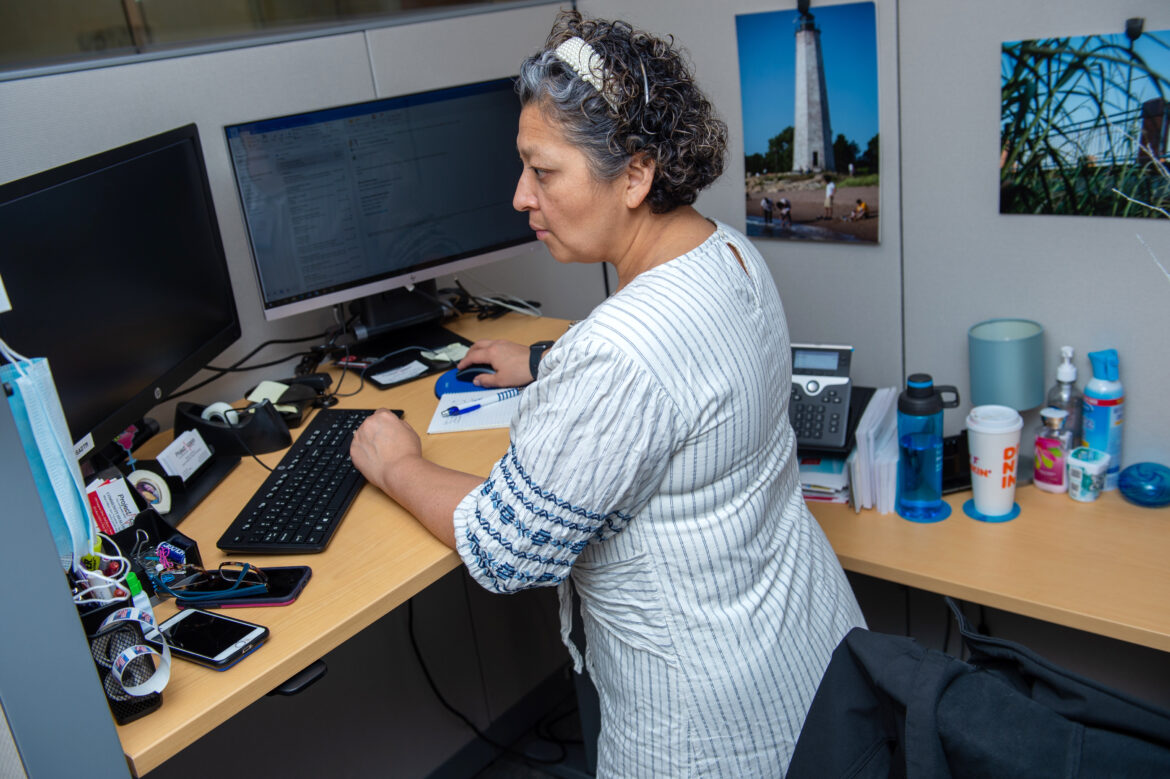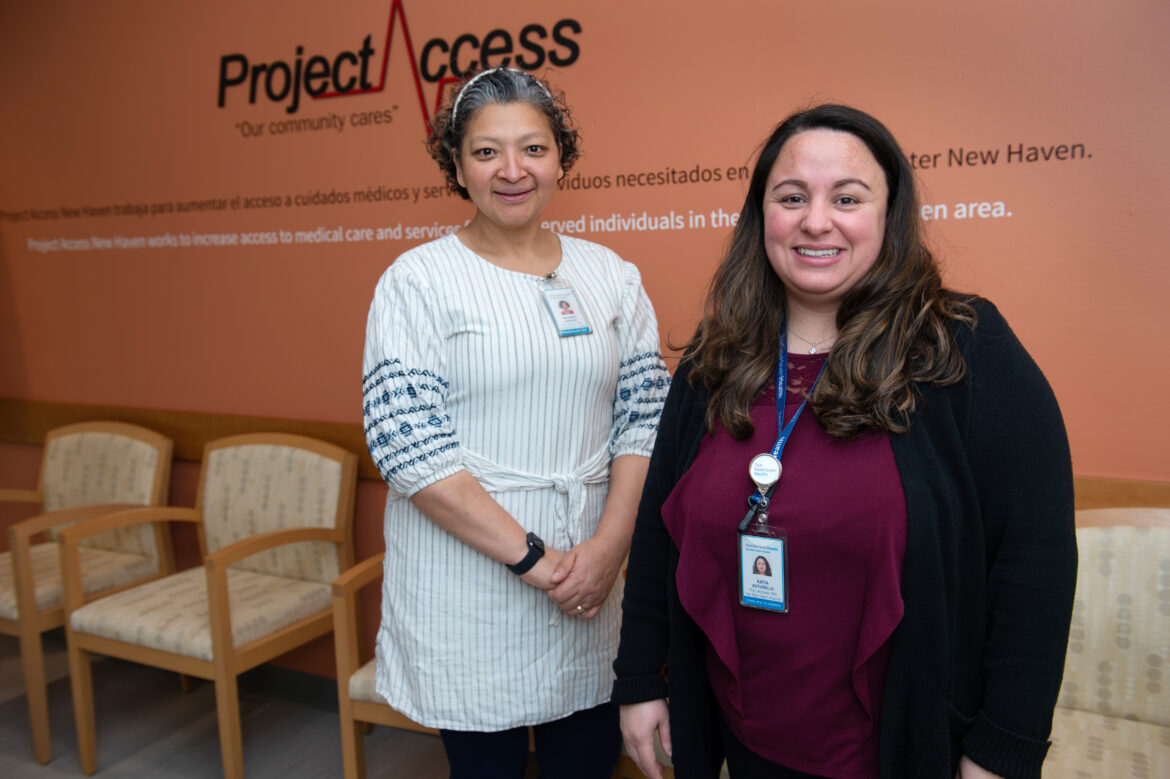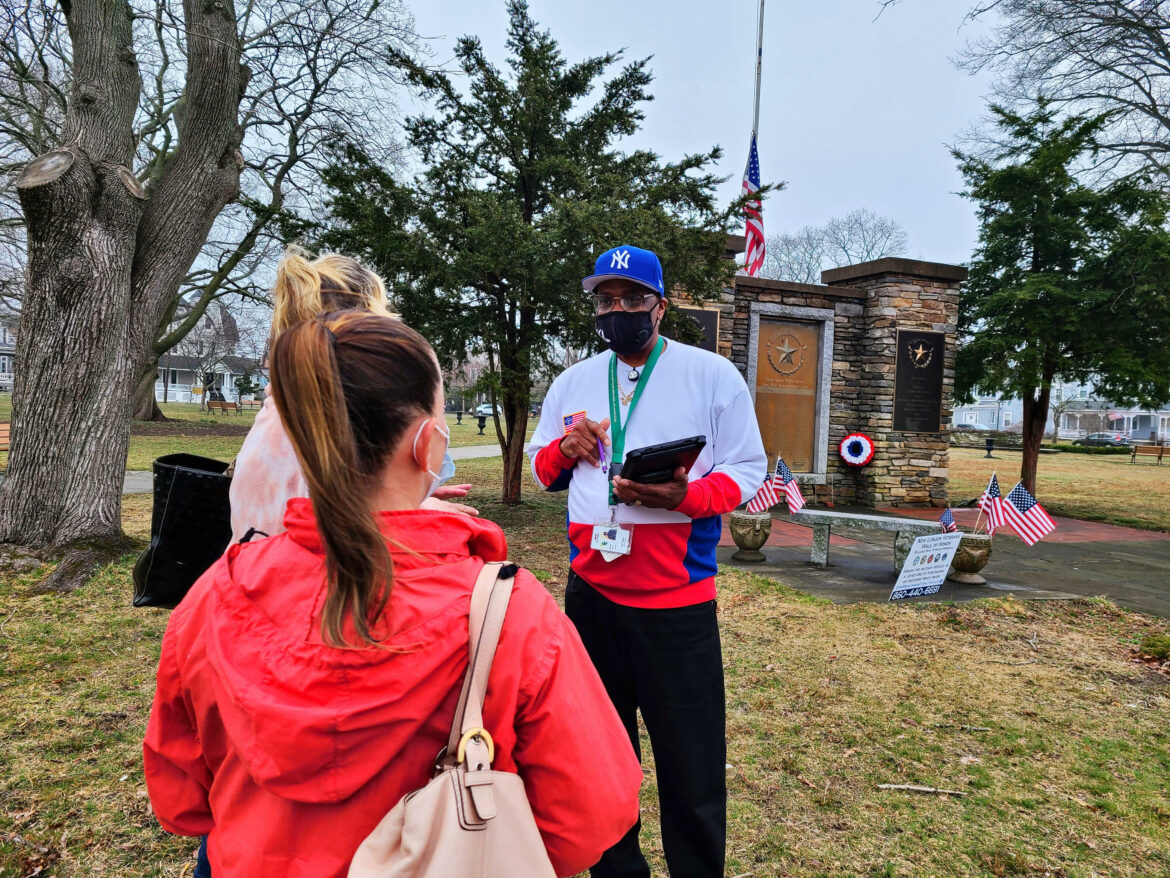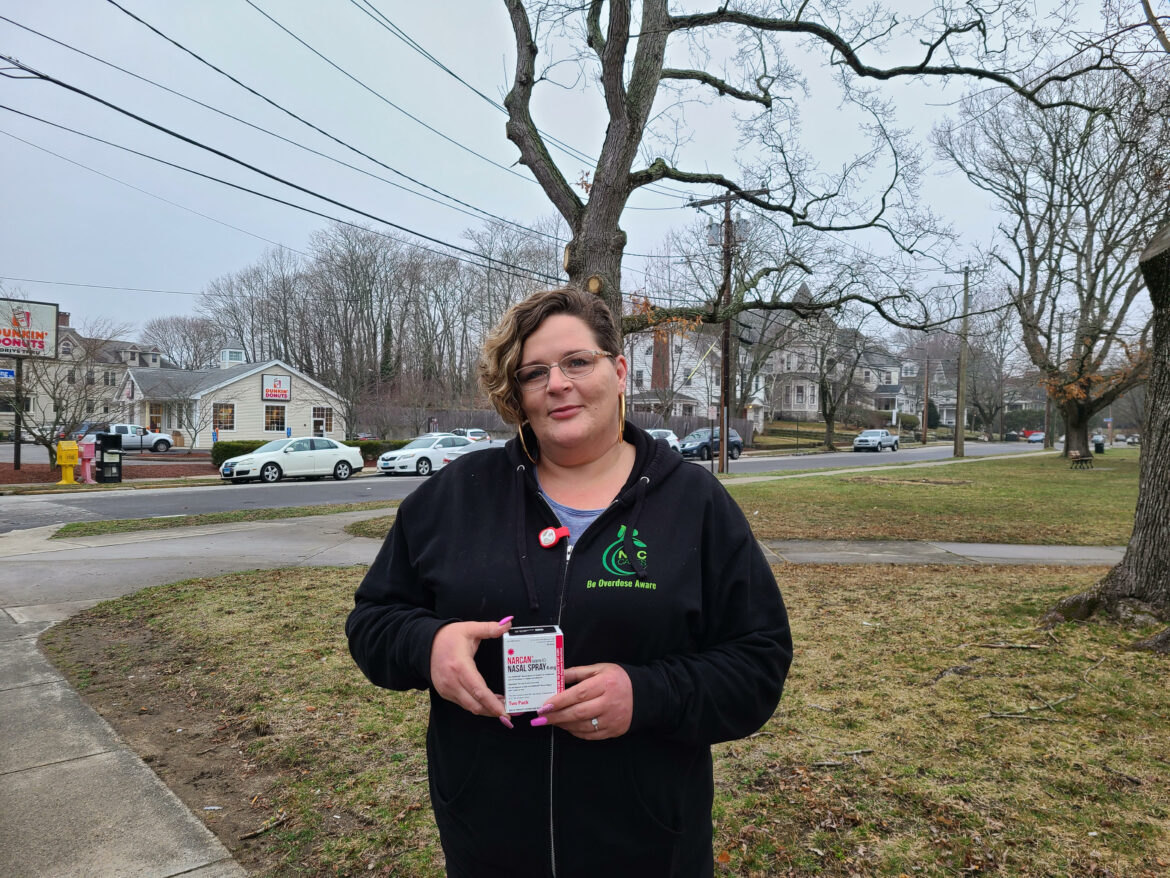By Cara Rosner

Cloe Poisson Photo.
Millie Landock, Lead Community Health Worker at Project Access New Haven, talks to a client on the phone while doing outreach to connect residents to health providers.
New Haven Community Health Worker (CHW) Katia Astudillo helps dozens of her clients navigate the logistics of getting vaccinated and connects them with other health services. She even helps them find rental assistance.
In and around New London, CHW Lizbeth Polo-Smith hands out flyers about COVID-19 safety and vaccinations at churches, laundromats, stores, warming centers for the homeless—anywhere she can.
As COVID-19 laid bare Connecticut’s health care deserts, it now highlights the efforts of CHWs who labored in forgotten neighborhoods for years. In many ways, they have become a key factor in the state’s public health response for marginalized communities during the pandemic.
“We need an army of CHWs. The capacity is just overwhelming right now,” said Giselle Carlotta-McDonald, executive director of Project Access-New Haven, which employs CHWs in a partnership with Yale New Haven Hospital.
But the pandemic has raised serious concerns about whether their work is sustainable in the long run. CHWs typically are funded by grant money, which advocates say is problematic.
“We are fully funded by grants and donations,” Carlotta-McDonald said. “I spend most of my time just looking for new funds for next year. Through the pandemic, we’ve lost grants that were scheduled to come this year. Without the funding, I can’t sustain it. It’s just not sustainable. It limits, really, how much we can do.”
Lifelines For Underserved Communities
Astudillo, a CHW at Project Access-New Haven, spends a lot of her time lately doing vaccine-related outreach.

Cloe Poisson Photo.
Millie Landock, lead CHW, and Katia Astudillo, Community Health Worker, stand in the lobby of Project Access New Haven. Landock and Astudillo work to close health disparities among residents by connecting them to health providers and social services.
“A lot of our clients are very hesitant of taking” a COVID-19 vaccine, she said. “They don’t know a lot about it. Some of our clients cannot read or write. There is a lot of education; our calls went from being 20 minutes to maybe 40 minutes.”
She’s also seen a surge in the number of people needing rental assistance. Many of the organization’s clients are undocumented and don’t qualify for federal resources, Astudillo said. She connects them with local organizations that can help.
Often, clients will share information with a CHW that they won’t tell a medical provider or another professional, said Millie Landock, lead CHW at Project Access.
“We are one of them,” said Landock, who has been a CHW for almost 15 years. “We speak what they speak. I know what you’re going through because I was there. They see us as one of them. When we call them, they share the personal stuff—their personal struggles, their personal life.”
She adds: “The needs were still there [before COVID-19]. Now it’s just, like, everywhere. The volume is just unbearable.”
Polo-Smith, who works as a CHW at Ledge Light Health District in New London, also educates people about the vaccines and helps them book and get to vaccine appointments. She spends part of her week passing out information in her community to anyone she can.
“I deliver flyers everywhere that people can reach,” she said. “Everybody trusts me. I enjoy what I do.”
CHWs live in the communities they serve, which is a crucial factor in their effectiveness, proponents say.

Ledge Light Photo.
Certified Community Health Worker Donnie Rose, of Alliance for Living, meets with community members at a New London park.
“This is not about us telling folks what to do,” said Jennifer Muggeo, deputy director of Ledge Light Health District. “This is about someone from their community who has trusted relationships and connections, and who knows how to navigate the different systems, and who knows what the barriers are, and can hear what people are hoping for and can help them achieve it.”
CHWs are especially critical in vaccine-related efforts, Muggeo said, as vaccination rates among people of color have trailed those of their white counterparts.
“We are really able to address the barriers that have existed for black, Hispanic and indigenous folks to get the vaccine,” Muggeo said, including lack of computer or internet access, transportation hardships, and trouble understanding English-only forms and websites. “We have worked hard to take those pieces down as much as we can.”
A Question Of Funding
CHWs have various titles and employment structures. Some are employed by health departments or health districts, some by community-based organizations, and some by health centers or hospitals.
“They really are on-the-ground individuals that are helping to guide patients, especially those who have complex issues, language barriers and other social determinant barriers,” said Tiffany Donelson, president and CEO of the Connecticut Health Foundation.
“CHWs were so instrumental in getting to hard-to-reach populations and doing so in order to educate them” in the pandemic’s early days, Donelson said. “They were instrumental in doing the contact tracing. For those who did get COVID, they were exceptionally helpful in getting them to the needed resources. They are so needed as it relates to educating around the vaccine because they are trusted in their community.”

Ledge Light Photo.
Certified Community Health Worker Trisha Rios, of Alliance for Living, distributes naloxone, PPE, food and other supplies to community members.
The Connecticut Health Foundation, through grants and in partnership with the nonprofit 4-CT, is funding 45 CHW positions throughout the state: in Bridgeport, Hartford, New Haven, Norwalk, Stamford and New London.
Before COVID-19, CHWs focused on various health-related issues. The Ledge Light Health District formed several years ago to address the opioid epidemic and social determinants related to asthma. Project Access started in 2009 to connect recently hospitalized patients with specialty care.
Now, CHWs are taking on a broader scope of work with no sustainable way to fund it. Project Access has six full-time CHWs, in addition to four full-time and two per-diem patient navigators who help uninsured patients access specialty care and address social health determinants, according to Carlotta-McDonald.
CHWs “are doing very, very important work, and we are constantly in a cycle of stressing and looking for the next grant funding to support their time,” Muggeo said.
Some recent developments could help.
President Joe Biden’s American Rescue Plan pledges to fund 100,000 public health workers who will work in local communities. According to the plan, they will provide services like vaccine outreach and contract tracing in the short term and then transition to long-term public health roles. The Centers for Disease Control and Prevention (CDC) expects to award grants to approximately 75 organizations through the program. But the grants will be awarded on a competitive basis, and not all entities will be funded.
Geralynn McGee, policy director of the Connecticut Health Foundation, said, “The support in the American Rescue Plan is helpful, but we should continue to consider how we can sustainably fund CHWs,” she said. “This one-time cash infusion is still more like a grant.”
About a year and a half ago, the Connecticut Department of Public Health created a certification for CHWs, which Muggeo said is an encouraging step in getting CHWs the recognition—and funding—they deserve. To date, 120 people have earned the optional certification.
“I hope, as a state, we’re able to look in a broader way” at funding opportunities, Muggeo said.
State lawmakers are debating the next biennial budget amid a challenging financial climate. State Rep. Patricia Dillon (D-New Haven), a deputy majority leader who sits on the Appropriations Committee and co-chairs its subcommittee on public health, said a bipartisan staff is researching if and how the budget may affect CHWs.
Donelson said that steady funding would make CHWs even more effective.
“We need to continue to figure out how we can support this workforce so they can really help us. We really need people who are boots on the ground. It’s a question of funding them,” Donelson said.
Support Our Work
The Conn. Health I-Team is dedicated to producing original, responsible, in-depth journalism on key issues of health and safety that affect our readers, and helping them make informed health care choices. As a nonprofit, we rely on donations to help fund our work.Donate Now
Subscribe to our monthly newsletter!
Get news from the Connecticut Health Investigative Team in your inbox. Email
By submitting this form, you are consenting to receive marketing emails from: Connecticut Health Investigative Team, 346 Alden Avenue, New Haven, CT, 06515, US, http://www.c-hit.org. You can revoke your consent to receive emails at any time by using the SafeUnsubscribe® link, found at the bottom of every email. Emails are serviced by Constant Contact.

Related Stories
- Plan To Expand Child Tax Credit Offers Hope Along With Direct Payments When her car started making a noise more than a year ago, Chinara Johnson parked the vehicle and hasn’t used it since. As a New Haven mother of 5-year-old twin boys, one of whom is on the autism spectrum, and an 8-year-old daughter, Johnson doesn’t have the money to get the car running properly again.


